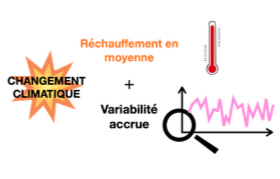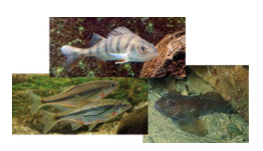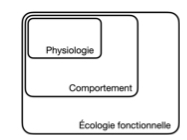
SOUQUES Chloé
Doctorant : E2C
Université Lyon 1
CNRS, UMR 5023 - LEHNA,
Laboratoire d'Ecologie des Hydrosystèmes Naturels et Anthropisés
3, rue Raphaël Dubois - Bât. Darwin C
F-69622 Villeurbanne Cedex FRANCE
-
Cette adresse e-mail est protégée contre les robots spammeurs. Vous devez activer le JavaScript pour la visualiser.


Un changement climatique d’origine anthropique et extrêmement rapide, confrontant la biodiversité à des bouleversements majeurs, est aujourd’hui largement documenté (IPCC, 2023). S’il est le plus souvent envisagé comme une hausse progressive des températures moyennes, il s’accompagne aussi d’une augmentation de la stochasticité thermique et d’une plus forte occurrence d’évènements climatiques extrêmes, rendant les conditions de vie moins prévisibles pour les organismes (Easterling et al., 2000).
 Or, jusqu’à récemment, c’est principalement la question de la dérive des températures moyennes qui a monopolisé l’effort de recherche. Les effets de la variabilité thermique sur les organismes et la résilience des écosystèmes sont ainsi largement inexplorés, conduisant à une possible sous-estimation de l’impact réel de ce changement global (Jørgensen et al., 2022; Vasseur et al., 2014).
Or, jusqu’à récemment, c’est principalement la question de la dérive des températures moyennes qui a monopolisé l’effort de recherche. Les effets de la variabilité thermique sur les organismes et la résilience des écosystèmes sont ainsi largement inexplorés, conduisant à une possible sous-estimation de l’impact réel de ce changement global (Jørgensen et al., 2022; Vasseur et al., 2014).
Ce travail de thèse vise donc à documenter l'effet de stress thermiques aigus, répétés et aléatoires. Pour explorer cette question, nous adopterons une approche intégrative en mesurant cette réponse des vertébrés ectothermes, les poissons d'eau douce, à différentes échelles. La première est la réponse physiologique immédiate, permettant de survivre à un stress thermique modéré mais qui est aussi très énergivore (Voituron et al., 2022). De fait, les coûts énergétiques seront évalués via la mesure du métabolisme in vivo. Nous la compléterons par des mesures à une autre échelle, celle de paramètres comportementaux (prédation, activité, répartition spatiale, choix des habitats). Le succès écologique d'une espèce est largement déterminé par l'utilisation des ressources, via les interactions trophiques. L'impact trophique des espèces sera décrit au moyen de mesures de réponse fonctionnelle, correspondant à la relation entre taux de consommation et densité de proies disponibles (Holling, 1959).
La première est la réponse physiologique immédiate, permettant de survivre à un stress thermique modéré mais qui est aussi très énergivore (Voituron et al., 2022). De fait, les coûts énergétiques seront évalués via la mesure du métabolisme in vivo. Nous la compléterons par des mesures à une autre échelle, celle de paramètres comportementaux (prédation, activité, répartition spatiale, choix des habitats). Le succès écologique d'une espèce est largement déterminé par l'utilisation des ressources, via les interactions trophiques. L'impact trophique des espèces sera décrit au moyen de mesures de réponse fonctionnelle, correspondant à la relation entre taux de consommation et densité de proies disponibles (Holling, 1959).Pour étudier ces réponses physiologiques, comportementales et trophiques, nous nous intéresserons à des poissons présents en Saône, incluant à la fois des espèces natives et invasives. À ce titre, une méthode innovante sera mise en œuvre en vue d’exposer les individus à différents régimes thermiques, fluctuants et constants. Un intérêt particulier sera porté sur la plasticité des réponses et le lien entre ces différents niveaux de réponse. Nous cherchons notamment à éprouver l'idée qu'une plasticité métabolique contraint la flexibilité comportementale. Face à l’augmentation prédite de la stochasticité thermique, nous nous attacherons également à éclairer la vulnérabilité ou la résilience des espèces à la lumière de leur statut de conservation.
Easterling, D. R., Meehl, G. A., Parmesan, C., Changnon, S. A., Karl, T. R., & Mearns, L. O. (2000). Climate Extremes: Observations, Modeling, and Impacts. Science, 289(5487), 2068–2074. https://doi.org/10.1126/science.289.5487.2068
Holling, C. S. (1959). Some Characteristics of Simple Types of Predation and Parasitism. The Canadian Entomologist, 91(7), 385–398. https://doi.org/10.4039/Ent91385-7
Jørgensen, L. B., Ørsted, M., Malte, H., Wang, T., & Overgaard, J. (2022). Extreme escalation of heat failure rates in ectotherms with global warming. Nature, 611(7934), 93–98. https://doi.org/10.1038/s41586- 022-05334-4
Vasseur, D. A., DeLong, J. P., Gilbert, B., Greig, H. S., Harley, C. D. G., McCann, K. S., Savage, V., Tunney, T. D., & O’Connor, M. I. (2014). Increased temperature variation poses a greater risk to species than climate warming. Proceedings of the Royal Society B: Biological Sciences, 281(1779), 20132612. https://doi.org/10.1098/rspb.2013.2612
Voituron, Y., Roussel, D., Teulier, L., Vagner, M., Ternon, Q., Romestaing, C., Dubillot, E., & Lefrancois, C. (2022). Warm Acclimation Increases Mitochondrial Efficiency in Fish: A Compensatory Mechanism to Reduce the Demand for Oxygen. Physiological and Biochemical Zoology, 95(1), 15–21. https://doi.org/10.1086/716904
An extremely rapid anthropogenic climate change, confronting biodiversity to major threats, has now been widely documented (IPCC, 2023). Although it is most often considered as a gradual rise in average temperatures, it is also associated with an increase in thermal stochasticity and a higher occurrence of extreme climatic events, making living conditions less predictable for organisms (Easterling et al., 2000).
 However, until recently, climate change research has focused mainly on the issue of mean temperature drift. The effects of thermal variability on organisms and ecosystem resilience are still largely unexplored, leading to a possible underestimation of the real impact of this global change (Jørgensen et al., 2022 ; Vasseur et al., 2014).
However, until recently, climate change research has focused mainly on the issue of mean temperature drift. The effects of thermal variability on organisms and ecosystem resilience are still largely unexplored, leading to a possible underestimation of the real impact of this global change (Jørgensen et al., 2022 ; Vasseur et al., 2014).
The aim of this thesis is therefore to document the effect of acute, repeated and random thermal stresses. To explore this question, an integrative approach will be adopted by measuring the response of ectothermic vertebrates, freshwater fish, at different scales. The first one is the immediate physiological response, allowing survival under moderate thermal stress, but which is also highly energy consuming (Voituron et al., 2022). Energy costs will be assessed by measuring metabolism in vivo. These will be complemented by measurements on another scale, namely behavioural parameters (predation, activity, spatial distribution, choice of habitats). The ecological success of a species is largely determined by its use of resources, via trophic interactions. The trophic impact of species will be described through functional response measurements, corresponding to the relationship between consumption rate and density of available prey (Holling, 1959).
The first one is the immediate physiological response, allowing survival under moderate thermal stress, but which is also highly energy consuming (Voituron et al., 2022). Energy costs will be assessed by measuring metabolism in vivo. These will be complemented by measurements on another scale, namely behavioural parameters (predation, activity, spatial distribution, choice of habitats). The ecological success of a species is largely determined by its use of resources, via trophic interactions. The trophic impact of species will be described through functional response measurements, corresponding to the relationship between consumption rate and density of available prey (Holling, 1959).To study these physiological, behavioural and trophic responses, we will work on fish living
in the Saône river, including both native and invasive species. An innovative method will be used to expose individuals to different thermal regimes, both fluctuating and constant. Particular attention will be paid to the plasticity of responses and the link between these different levels of response. In particular, we aim to test the idea that metabolic plasticity constrains behavioural flexibility. Considering the anticipated increase in thermal stochasticity, we will also attempt to examine the vulnerability or resilience of species in the light of their conservation status.Easterling, D. R., Meehl, G. A., Parmesan, C., Changnon, S. A., Karl, T. R., & Mearns, L. O. (2000). Climate Extremes: Observations, Modeling, and Impacts. Science, 289(5487), 2068–2074. https://doi.org/10.1126/science.289.5487.2068
Holling, C. S. (1959). Some Characteristics of Simple Types of Predation and Parasitism. The Canadian Entomologist, 91(7), 385–398. https://doi.org/10.4039/Ent91385-7
Jørgensen, L. B., Ørsted, M., Malte, H., Wang, T., & Overgaard, J. (2022). Extreme escalation of heat failure rates in ectotherms with global warming. Nature, 611(7934), 93–98. https://doi.org/10.1038/s41586- 022-05334-4
Vasseur, D. A., DeLong, J. P., Gilbert, B., Greig, H. S., Harley, C. D. G., McCann, K. S., Savage, V., Tunney, T. D., & O’Connor, M. I. (2014). Increased temperature variation poses a greater risk to species than climate warming. Proceedings of the Royal Society B: Biological Sciences, 281(1779), 20132612. https://doi.org/10.1098/rspb.2013.2612
Voituron, Y., Roussel, D., Teulier, L., Vagner, M., Ternon, Q., Romestaing, C., Dubillot, E., & Lefrancois, C. (2022). Warm Acclimation Increases Mitochondrial Efficiency in Fish: A Compensatory Mechanism to Reduce the Demand for Oxygen. Physiological and Biochemical Zoology, 95(1), 15–21. https://doi.org/10.1086/716904
- 2025 Souques, C., Bacon, J., Guillard, L., Eymard-Dauphin, L., Teulier, L., Dechaume-Moncharmont, F.X., Bittebiere A.K., Voituron, Y., 2025 - All‐in‐one, versatile and low‐cost experimental set‐up to implement environmental stochasticity in mesocosms ( PiStoch ). Methods in Ecology and Evolution, 2025, 16, pp.1955-1965. ⟨10.1111/2041-210X.70094⟩2025 Watson, J., Souques, C., Dechaume-Moncharmont, F.X., Roussel, D., [...], Guillard, L., [...], Morales-Montaron, A., Voituron, Y.,, [...], Teulier, L., 2025 - A multi-scaling approach showing a transient metabolic mismatch in a freshwater fish ( Zingel asper ) during an acute heat stress. Journal of Experimental Biology, 228 (10), ⟨10.1242/jeb.250202⟩































